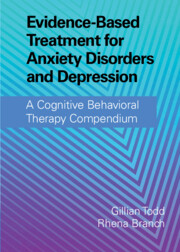 Evidence-Based Treatment for Anxiety Disorders and Depression
Evidence-Based Treatment for Anxiety Disorders and Depression Book contents
- Evidence-Based Treatment for Anxiety Disorders and Depression
- Evidence-Based Treatment for Anxiety Disorders and Depression
- Copyright page
- Contents
- Figures
- Tables
- Contributors
- 1 Introduction
- 2 The History and Philosophical Underpinnings of CBT:
- Part One Cognitive Behavioral Therapy for Anxiety Disorders
- Part Two Cognitive Behavioral Therapy for Posttraumatic Stress Disorder
- Part Three Cognitive Behavioral Therapy for Obsessive-Compulsive Disorder and Associated Disorders
- Part Four Cognitive Behavioral Therapy for Depression
- 18 Behavioral Activation
- 19 CBT for Persistent Depressive Disorder
- 20 Rumination-Focused Cognitive Behavioral Therapy
- 21 Cognitive Behavioral Therapy for Perinatal Depression
- Part Five Complexity and Comorbidity in Anxiety Disorders and Depression:
- Part Six Specialist Applications of Cognitive Behavioral Therapy for Anxiety Disorders and Depression
- Part Seven Future Developments
- Appendices
- Index
- References
21 - Cognitive Behavioral Therapy for Perinatal Depression
from Part Four - Cognitive Behavioral Therapy for Depression
Published online by Cambridge University Press: 06 January 2022
- Evidence-Based Treatment for Anxiety Disorders and Depression
- Evidence-Based Treatment for Anxiety Disorders and Depression
- Copyright page
- Contents
- Figures
- Tables
- Contributors
- 1 Introduction
- 2 The History and Philosophical Underpinnings of CBT:
- Part One Cognitive Behavioral Therapy for Anxiety Disorders
- Part Two Cognitive Behavioral Therapy for Posttraumatic Stress Disorder
- Part Three Cognitive Behavioral Therapy for Obsessive-Compulsive Disorder and Associated Disorders
- Part Four Cognitive Behavioral Therapy for Depression
- 18 Behavioral Activation
- 19 CBT for Persistent Depressive Disorder
- 20 Rumination-Focused Cognitive Behavioral Therapy
- 21 Cognitive Behavioral Therapy for Perinatal Depression
- Part Five Complexity and Comorbidity in Anxiety Disorders and Depression:
- Part Six Specialist Applications of Cognitive Behavioral Therapy for Anxiety Disorders and Depression
- Part Seven Future Developments
- Appendices
- Index
- References
Summary
Cognitive behavioral therapy (CBT) is an effective treatment for perinatal distress. Adapting CBT for perinatal patients requires the clinician to consider characteristics specific to this population. The assessment process must be informed by knowledge of normative changes associated with pregnancy and the early months of parenthood, and treatment strategies may require modification to address challenges related to pregnancy or parenting. This chapter provides an overview of mental health concerns during pregnancy and the early postpartum period, summarizes the research demonstrating the efficacy of CBT in this population, and describes ways in which CBT can be effectively adapted for treating depression and related problems during the transition to parenthood.
Keywords
- Type
- Chapter
- Information
- Evidence-Based Treatment for Anxiety Disorders and DepressionA Cognitive Behavioral Therapy Compendium, pp. 418 - 458Publisher: Cambridge University PressPrint publication year: 2022


